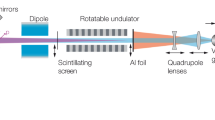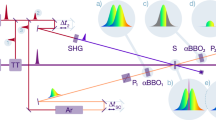Abstract
Controlling the group velocity of an ultrashort laser pulse by means of spatio-temporal couplings has been proposed to overcome the inherent limitations in laser–plasma interactions. Here we report how this method improves the performance of a seeded soft X-ray laser (SXRL), which intrinsically suffers from group velocity mismatch between the infrared pump beam, used to generate the plasma amplifier, and the soft X-ray seed beam. The energy extraction was measured to be three times higher when the pump group velocity varied from 0.55c to 1.05c. We also demonstrate that the SXRL pulse duration is governed by the pump beam velocity. By compensating the natural group velocity mismatch, the SXRL pulse duration can be kept constant along its propagation, resulting in energetic pulses (up to 2 μJ) as short as 350 fs. Such achievements constitute an experimental demonstration of the so-called ‘flying focus effect’ in an application by controlling the group velocity of a high-intensity laser pulse propagating in a plasma.
This is a preview of subscription content, access via your institution
Access options
Access Nature and 54 other Nature Portfolio journals
Get Nature+, our best-value online-access subscription
$29.99 / 30 days
cancel any time
Subscribe to this journal
Receive 12 print issues and online access
$209.00 per year
only $17.42 per issue
Buy this article
- Purchase on Springer Link
- Instant access to full article PDF
Prices may be subject to local taxes which are calculated during checkout





Similar content being viewed by others
Data availability
The main datasets supporting the findings of this study are provided within the paper. Additional data are available from the corresponding authors upon reasonable request.
References
Eliezer, S. & Mima, K. Applications of Laser-Plasma Interactions (CRC Press, 2009).
Malka, V. et al. Principles and applications of compact laser–plasma accelerators. Nat. Phys. 4, 447–453 (2008).
Esarey, E., Schroeder, C. B. & Leemans, W. P. Physics of laser-driven plasma-based electron accelerators. Rev. Mod. Phys. 81, 1229–1285 (2009).
Mendonca, J. T. Theory of Photon Acceleration (CRC Press, 2000).
Andriyash, I., Balcou, P. & Tikhonchuk, V. Collective properties of a relativistic electron beam injected into a high intensity optical lattice. Eur. Phys. J. D 65, 533–540 (2011).
Debus, A. et al. Circumventing the dephasing and depletion limits of laser-wakefield acceleration. Phys. Rev. X 9, 031044 (2019).
Palastro, J. P. et al. Dephasingless laser wakefield acceleration. Phys. Rev. Lett. 124, 134802 (2020).
Caizergues, C., Smartsev, S., Malka, V. & Thaury, C. Phase-locked laser-wakefield electron acceleration. Nat. Photon. 14, 475–479 (2020).
Sainte-Marie, A., Gobert, O. & Quéré, F. Controlling the velocity of ultrashort light pulses in vacuum through spatio-temporal couplings. Optica 4, 1298–1304 (2017).
Froula, D. H. et al. Spatiotemporal control of laser intensity. Nat. Photon. 12, 262–265 (2018).
Jolly, S. W., Gobert, O., Jeandet, A. & Quéré, F. Controlling the velocity of a femtosecond laser pulse using refractive lenses. Opt. Express 18, 4888–4897 (2020).
Turnbull, D. et al. Ionization waves of arbitrary velocity. Phys. Rev. Lett. 120, 225001 (2018).
Franke, P. et al. Measurement and control of large diameter ionization waves of arbitrary velocity. Opt. Express 27, 31978–31988 (2019).
Howard, A. J. et al. Photon acceleration in a flying focus. Phys. Rev. Lett. 123, 124801 (2018).
Turnbull, D. et al. Raman amplification with a flying focus. Phys. Rev. Lett. 120, 024801 (2018).
Rus, B. et al. Multimillijoule, highly coherent X-ray laser at 21-nm operating in deep saturation through double-pass amplification. Phys. Rev. A 66, 063806 (2002).
Rockwood, A. et al. Compact gain-saturated X-ray lasers down to 6.85 nm and amplification down to 5.85 nm. Optica 5, 257–262 (2018).
Lemoff, B. E., Barty, C. P. & Harris, S. E. Femtosecond-pulse-driven, electron-excited XUV lasers in eight-times-ionized noble gases. Opt. Lett. 19, 569–571 (1994).
Tissandier, F. et al. Two-color soft X-ray lasing in a high-density nickel-like krypton plasma. Phys. Rev. Lett. 124, 133902 (2020).
Wang, Y. et al. High-brightness injection-seeded soft-X-ray-laser amplifier using a solid target. Phys. Rev. Lett. 97, 123901 (2006).
Sebban, S. et al. Demonstration of a Ni-like Kr optical-field-ionization collisional soft X-ray laser at 32.8 nm. Phys. Rev. Lett. 89, 253901 (2002).
Zeitoun, P. et al. A high-intensity highly coherent soft X-ray femtosecond laser seeded by a high harmonic beam. Nature 431, 426–429 (2004).
Wang, Y. et al. Phase-coherent, injection-seeded, table-top soft-X-ray lasers at 18.9 nm and 13.9 nm. Nat. Photon. 2, 94–98 (2008).
Goddet, J. P. et al. Aberration-free laser beam in the soft X-ray range. Opt. Lett. 34, 2438–2440 (2009).
Depresseux, A. et al. Table-top femtosecond soft X-ray laser by collisional ionization gating. Nat. Photon. 9, 817–821 (2015).
Kabacinski, A. et al. Femtosecond soft X-ray lasing in dense collisionaly-pumped plasma. Phys. Rev. Res. 4, L032009 (2022).
Klisnick, A. et al. Transient pumping of a Ni-like Ag X-ray laser with a subpicosecond pump pulse in a traveling-wave irradiation geometry. J. Opt. Soc. Am. B 17, 1093–1097 (2000).
Oliva, E. et al. DAGON: a 3D Maxwell-Bloch code. In Proc. SPIE 10243, X-ray Lasers and Coherent X-ray Sources: Development and Applications Vol. 10243 (SPIE, 2017); https://doi.org/10.1117/12.2265044
Wang, Y. et al. Measurement of 1-ps soft X-ray laesr pulses from an injection-seeded plasma amplifier. Phys. Rev. A 79, 023810 (2009).
Helk, T. et al. Table-top extreme ultraviolet second harmonic generation. Sci. Adv. https://doi.org/10.1126/sciadv.abe2265 (2021).
Sokolowski-Tinten, K. et al. Femtosecond X-ray measurement of coherent lattice vibrations near the Lindemann stability limit. Nature 422, 287–289 (2003).
Chou, M. C. et al. Dramatic enhancement of optical-field-ionization collisional-excitation X-ray lasing by an optically preformed plasma waveguide. Phys. Rev. Lett. 99, 063904 (2007).
Oliva, E. et al. Hydrodynamic evolution of plasma waveguides for soft-X-ray amplifiers. Phys. Rev. E 97, 023203 (2018).
Kabacinski, A. et al. Measurement and control of main spatio-temporal couplings in a CPA laser chain. J. Opt. 23, 06LT01 (2021).
Oliva, E. et al. 3D multi-scale modelling of plasma-based seeded soft X-ray lasers. Eur. Phys. J. D https://doi.org/10.1140/epjd/s10053-021-00298-y (2021).
Ogando, F. & Velarde, P. Development of a radiation transport fluid dynamic code under AMR scheme. J. Quant. Spectrosc. Radiat. Transf. 71, 541–550 (2001).
Cotelo, M. et al. Simulation of radiative shock waves in Xe of last PALS experiments. High Energy Density Phys. 17, 68–73 (2015).
Lehe, R., Kirchen, M., Andriyash, I. A., Godfrey, B. B. & Vay, J.-L. A spectral, quasi-cylindrical and dispersion-free particle-in-cell algorithm. Comput. Phys. Commun. 203, 66–82 (2016).
Cros, B. et al. Characterization of the collisionally pumped optical-field-ionized soft-X-ray laser at 41.8 nm driven in capillary tubes. Phys. Rev. A 73, 033801 (2006).
Tuitje, F. et al. Nonlinear ionization dynamics of hot dense plasma observed in a laser-plasma amplifier. Light. Sci. Appl. https://doi.org/10.1038/s41377-020-00424-2 (2020).
Acknowledgements
This work is supported by ‘Investissement d’Avenir’ (ANR-10-LABX-0039-PALM (F.T. and S.S.) and ANR-18-EURE-0014 (A.K.)) and has received funding from the European Union’s Horizon 2020 research and innovation programme under grant agreement no. 654148 Laserlab-Europe. This work is also supported by the Grant Agency of the Czech Republic, project no. 18-27340S (M.Z.). We acknowledge support from COST (European Cooperation in Science and Technology) for funding the Action TUMIEE (CA17126) supporting this work. This work is also supported by the Universidad Politécnica de Madrid and the Comunidad Autónoma de Madrid, línea de actuación estímulo a la investigación de jóvenes doctores, project CROM and the Spanish Ministerio de Ciencia e Innovación through a Ramón y Cajal RYC2018-026238-I fellowship (E.O.), and by Plan Estatal de Investigación Científica, Técnica y de Innovación (Spain Ministerio de Ciencia e Innovación), grant no. PID2021-124129OB-I00 (E.O.).
Author information
Authors and Affiliations
Contributions
A.K., F.T., J.G., M.K. and S.S. designed and built the experiment and performed the measurements. A.K. analysed the experimental results. E.O. developed the DAGON code. E.O. and A.K. performed the numerical simulations. J.-P.G. operated the upgraded laser system of ‘Salle Jaune’. I.A.A., C.T. and P.Z. supported the project. All the authors contributed to the writing of the paper.
Corresponding author
Ethics declarations
Competing interests
The authors declare no competing interests.
Peer review
Peer review information
Nature Photonics thanks Samuel Barber and the other, anonymous, reviewer(s) for their contribution to the peer review of this work.
Additional information
Publisher’s note Springer Nature remains neutral with regard to jurisdictional claims in published maps and institutional affiliations.
Supplementary information
Supplementary Information
Supplementary discussion: dephasing length and need for plasma dispersion compensation in the case of seeded SXRLs (Figs. 1 and 2 and one reference), and energy measurements and definition of energy extraction (Fig. 3).
Rights and permissions
Springer Nature or its licensor (e.g. a society or other partner) holds exclusive rights to this article under a publishing agreement with the author(s) or other rightsholder(s); author self-archiving of the accepted manuscript version of this article is solely governed by the terms of such publishing agreement and applicable law.
About this article
Cite this article
Kabacinski, A., Oliva, E., Tissandier, F. et al. Spatio-temporal couplings for controlling group velocity in longitudinally pumped seeded soft X-ray lasers. Nat. Photon. 17, 354–359 (2023). https://doi.org/10.1038/s41566-023-01165-5
Received:
Accepted:
Published:
Issue Date:
DOI: https://doi.org/10.1038/s41566-023-01165-5
This article is cited by
-
Plasma interactions with bespoke laser pulses
Nature Photonics (2023)



